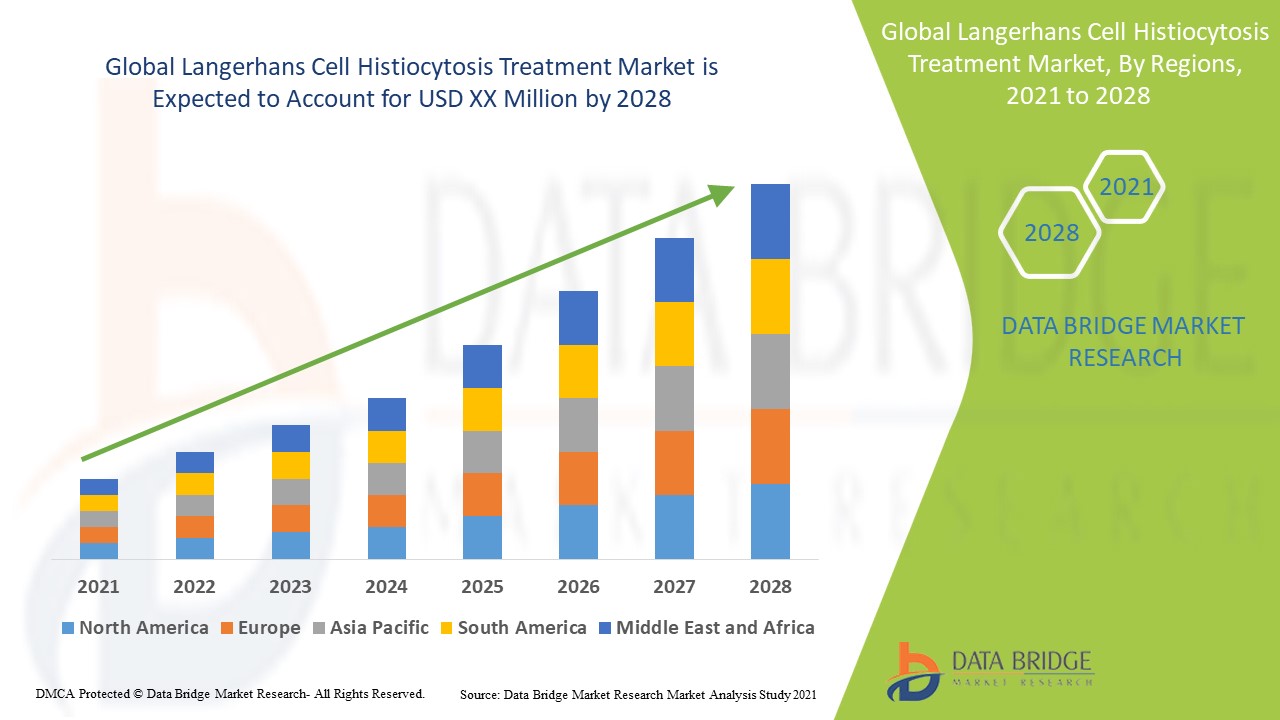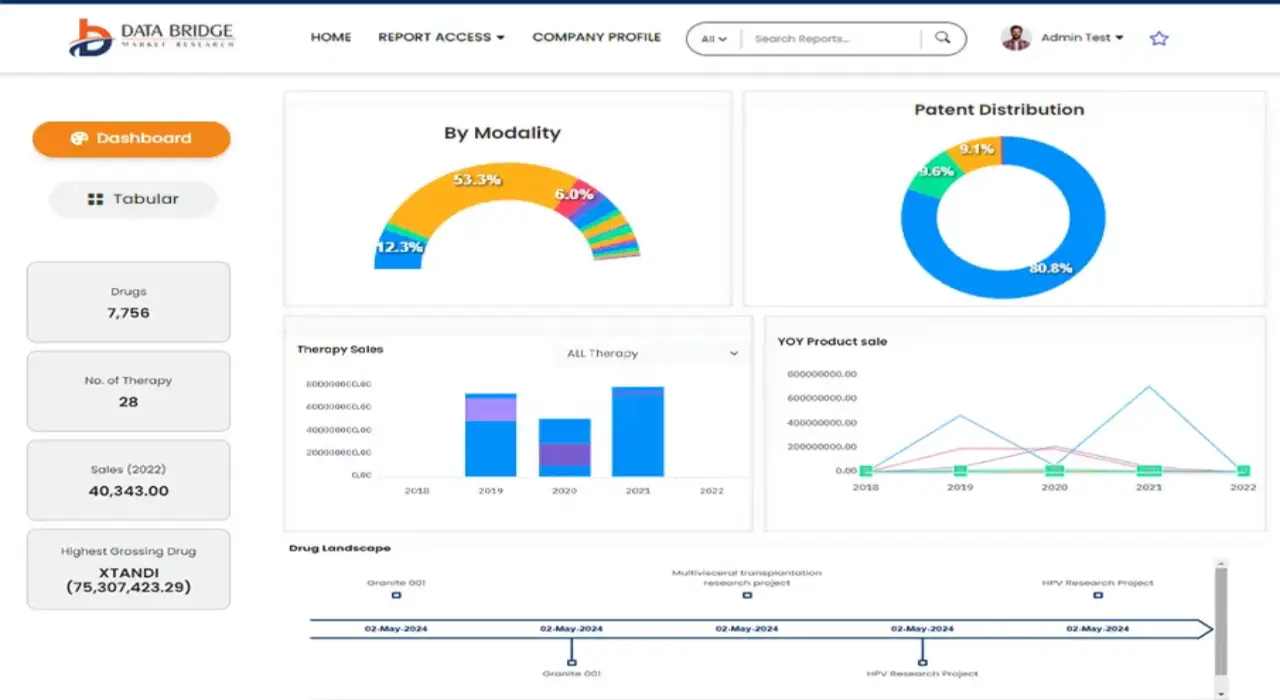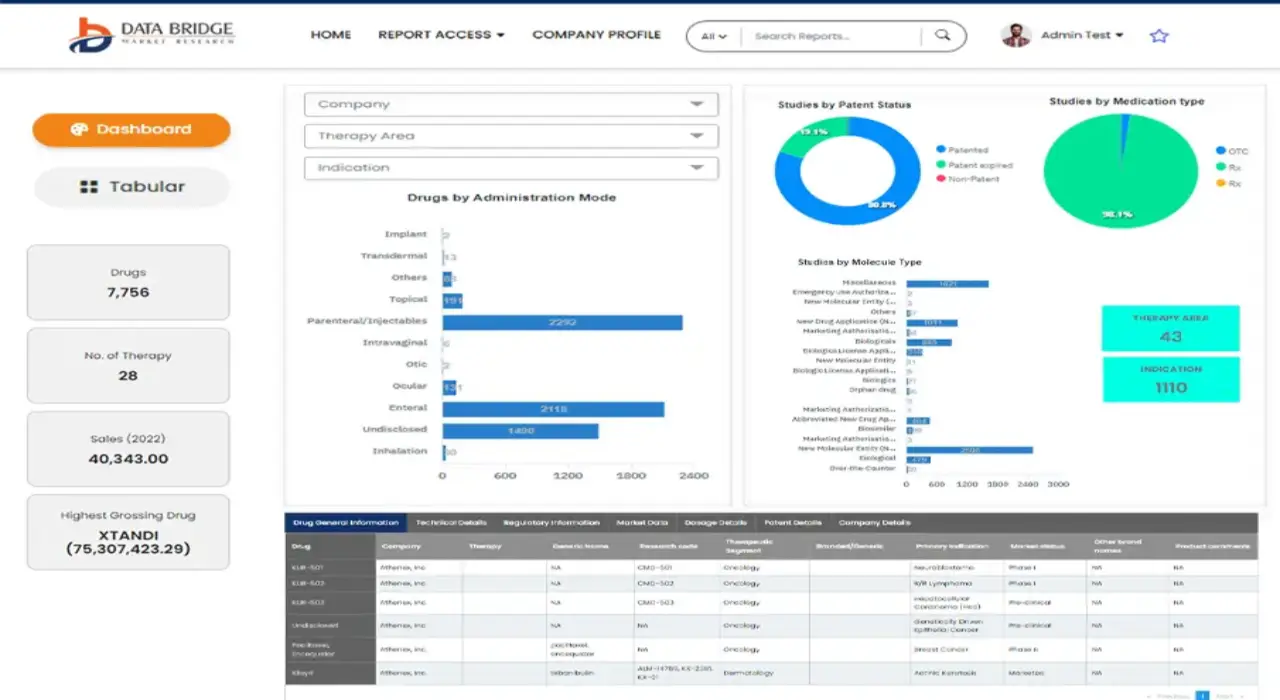Global Langerhans Cell Histiocytosis Treatment Market
市场规模(十亿美元)
CAGR :
% 
 USD
1.36 Billion
USD
2.05 Billion
2024
2032
USD
1.36 Billion
USD
2.05 Billion
2024
2032
| 2025 –2032 | |
| USD 1.36 Billion | |
| USD 2.05 Billion | |
|
|
|
|
Global Langerhans Cell Histiocytosis Treatment Market Segmentation, By Drugs (Prednisone, Vinblastine, 6-Mercaptopurine, Interferon-alpha, Anakinra and Others), Route of Administration (Oral, Parenteral, and Others), Distribution Channel (Hospital Pharmacy, Retail Pharmacy and Online Pharmacy), End-Users (Hospitals, Homecare, Specialty Clinics and Others) – Industry Trends and Forecast to 2032
Langerhans Cell Histiocytosis Treatment Market Analysis
Langerhans cell histiocytosis (LCH) treatment has seen significant advancements in recent years, particularly in targeted therapies and immunotherapies. The introduction of targeted agents such as vemurafenib and dabrafenib, which target the BRAF mutation commonly found in LCH, has shown promising results in treating refractory cases. In addition, monoclonal antibodies such as blinatumomab and rituximab are being utilized to modulate the immune response and improve outcomes, particularly for patients with high-risk disease. These therapies are being integrated into personalized treatment plans based on the genetic makeup of the tumors, allowing for more precise and effective interventions.
Furthermore, gene therapy and CRISPR-Cas9 technology are gaining traction in clinical trials, holding potential for correcting mutations at the genetic level. Advances in liquid biopsy methods allow for less invasive monitoring of disease progression and therapy response.
As research continues, the LCH treatment market is expected to grow, driven by the increasing adoption of these innovative therapies, improving survival rates, and offering hope for patients with previously limited treatment options.
Langerhans Cell Histiocytosis Treatment Market Size
The global langerhans cell histiocytosis treatment market size was valued at USD 1.36 billion in 2024 and is projected to reach USD 2.05 billion by 2032, with a CAGR of 5.30% during the forecast period of 2025 to 2032. In addition to the insights on market scenarios such as market value, growth rate, segmentation, geographical coverage, and major players, the market reports curated by the Data Bridge Market Research also include depth expert analysis, patient epidemiology, pipeline analysis, pricing analysis, and regulatory framework.
Langerhans Cell Histiocytosis Treatment Market Trends
“Rise in Focus on Immunotherapy Advancements”
One specific trend in the Langerhans Cell Histiocytosis (LCH) treatment market is the growing use of immunotherapy, particularly targeting specific molecular pathways involved in the disease. Immunotherapies, such as targeted therapies and immune checkpoint inhibitors, are being explored as effective treatments for LCH, which is a rare and often resistant cancer. For instance, the use of the BRAF inhibitor vemurafenib has shown promising results in cases of LCH with BRAF mutations. These therapies aim to modulate the immune system or block specific proteins to slow disease progression, offering more personalized treatment options compared to traditional chemotherapies drug. This trend is helping to improve treatment outcomes and quality of life for patients.
Report Scope and Langerhans Cell Histiocytosis Treatment Market Segmentation
|
Attributes |
Langerhans Cell Histiocytosis Treatment Key Market Insights |
|
Segments Covered |
|
|
Countries Covered |
U.S., Canada and Mexico in North America, Germany, France, U.K., Netherlands, Switzerland, Belgium, Russia, Italy, Spain, Turkey, Rest of Europe in Europe, China, Japan, India, South Korea, Singapore, Malaysia, Australia, Thailand, Indonesia, Philippines, Rest of Asia-Pacific (APAC) in the Asia-Pacific (APAC), Saudi Arabia, U.A.E, South Africa, Egypt, Israel, Rest of Middle East and Africa (MEA) as a part of Middle East and Africa (MEA), Brazil, Argentina and Rest of South America as part of South America |
|
Key Market Players |
Adimab (U.S.), Innovent Biologics, Inc. (China), Affimed GmbH (Germany), Amgen Inc. (U.S.), AstraZeneca (U.K.), Sanofi (France), F. Hoffmann-La Roche Ltd (Switzerland), Regeneron Pharmaceuticals Inc. (U.S.), Eli Lilly and Company (U.S.), Xencor (U.S.), Pieris Pharmaceuticals, Inc. (U.S.), Mereo BioPharma Group plc (U.K.), Sobi (Sweden), TG Therapeutics, Inc. (U.S.), Merus (Netherlands), MacroGenics, Inc. (U.S.), Genmab A/S (Denmark), Emergent BioSolutions Inc. (U.S.), Alteogen (South Korea), Astellas Pharma Inc. (Japan), and Novartis AG (Switzerland) |
|
Market Opportunities |
|
|
Value Added Data Infosets |
In addition to the insights on market scenarios such as market value, growth rate, segmentation, geographical coverage, and major players, the market reports curated by the Data Bridge Market Research also include depth expert analysis, patient epidemiology, pipeline analysis, pricing analysis, and regulatory framework. |
Langerhans Cell Histiocytosis Treatment Market Definition
Langerhans cell histiocytosis (LCH) treatment varies based on the severity and extent of the disease. For localized forms, surgical removal of lesions, radiation therapy, or local corticosteroids may be used. In more severe or widespread cases, systemic treatments are required. Chemotherapy (such as vinblastine and prednisone) is commonly prescribed for aggressive LCH, while newer therapies, including targeted biologics such as vemurafenib, may be used for cases with BRAF mutations. Hematopoietic stem cell transplantation is an option for those with refractory or relapsed LCH. Early diagnosis and personalized treatment strategies are critical for improving outcomes.
Langerhans Cell Histiocytosis Treatment Market Dynamics
Drivers
- Availability of New Targeted Therapies
The development of targeted therapies, such as BRAF inhibitors, has significantly expanded treatment options for Langerhans Cell Histiocytosis (LCH). BRAF inhibitors specifically target the BRAF V600E mutation, which is present in a significant number of LCH patients, offering a more precise and effective treatment compared to traditional therapies. For instance, the drug vemurafenib has shown promising results in treating LCH patients with this mutation, providing better control over the disease with fewer side effects. The availability of such therapies has generated increasing interest among both healthcare providers and patients, driving the LCH treatment market by offering a more personalized and effective approach to managing the condition.
- Growing Pediatric Population
The growing pediatric population significantly drives the Langerhans Cell Histiocytosis (LCH) treatment market, as LCH primarily affects children. According to the American Cancer Society, about 3,000 children are diagnosed with rare pediatric cancers such as LCH each year in the U.S. As this population increases, so does the need for specialized treatments tailored to young patients. This has led to a growing demand for therapies that not only target the disease effectively but also minimize long-term side effects, ensuring better quality of life for children. For instance, the use of targeted therapies such as vemurafenib has shown promise in pediatric cases, helping drive market growth for LCH treatments.
Opportunities
- Expansion of Orphan Drug Status and Incentives
Orphan drug status offers significant opportunities in the Langerhans Cell Histiocytosis (LCH) treatment market. Pharmaceutical companies developing therapies for rare diseases such as LCH receive incentives such as market exclusivity for up to seven years, tax credits, and research grants. These benefits reduce the financial burden of developing treatments for small patient populations, attracting more investment into LCH drug development. For instance, dabrafenib (a BRAF inhibitor) gained orphan drug status for LCH, enabling its development as a targeted treatment option. This regulatory support fosters innovation and increases the pipeline of effective therapies, ultimately benefiting patients and expanding the market's potential for growth.
- Rising Awareness of Rare Diseases
As awareness of rare diseases such as Langerhans cell histiocytosis (LCH) grows, the number of diagnoses has significantly increased, leading to greater demand for treatments. Increased research, media coverage, and awareness campaigns have helped educate both healthcare professionals and the general public about LCH, leading to early detection and more accurate diagnoses. For instance, the awareness raised by organizations such as the LCH Support Group has promoted discussions and research into effective treatments, spurring pharmaceutical companies to invest in developing targeted therapies. This growing recognition of LCH presents an opportunity for market expansion, encouraging the development of specialized treatments and improving patient access to care.
Restraints/Challenges
- High Treatment Costs
High treatment costs for Langerhans Cell Histiocytosis (LCH) pose a significant barrier to market growth. Therapies such as chemotherapy, targeted treatments, and stem cell transplants are often expensive, which limits access for many patients, particularly in low-income regions. The financial burden of these treatments can deter patients from seeking care or adhering to prescribed regimens, further exacerbating the challenges in managing the disease. In addition, the high costs can strain healthcare systems, limiting the resources allocated for LCH treatment. This economic constraint ultimately hinders the widespread adoption of effective therapies, delaying diagnosis and treatment, and slowing overall progress in addressing the disease.
- Uncertain Long-Term Outcomes
Uncertain long-term outcomes present a significant challenge in the Langerhans Cell Histiocytosis (LCH) treatment market. Many therapies, including chemotherapy and targeted treatments, do not guarantee complete remission or long-term survival, leading to a lack of confidence among both healthcare providers and patients. This uncertainty can result in reluctance to adopt certain treatment options, as patients often seek definitive and lasting solutions to their condition. As a result, the demand for LCH treatments may be hindered, affecting market growth. Furthermore, the lack of clear, long-term efficacy data complicates treatment decision-making, potentially delaying the adoption of available therapies and limiting the overall market potential.
This market report provides details of new recent developments, trade regulations, import-export analysis, production analysis, value chain optimization, market share, impact of domestic and localized market players, analyses opportunities in terms of emerging revenue pockets, changes in market regulations, strategic market growth analysis, market size, category market growths, application niches and dominance, product approvals, product launches, geographic expansions, technological innovations in the market. To gain more info on the market contact Data Bridge Market Research for an Analyst Brief, our team will help you take an informed market decision to achieve market growth.
Langerhans Cell Histiocytosis Treatment Market Scope
The market is segmented on the basis of drugs, route of administration, distribution channel and end-users. The growth amongst these segments will help you analyze meagre growth segments in the industries and provide the users with a valuable market overview and market insights to help them make strategic decisions for identifying core market applications.
Drugs
- Prednisone
- Vinblastine
- 6-Mercaptopurine
- Interferon-alpha
- Anakinra
- Others
Route of Administration
- Oral
- Parenteral
- Others
Distribution Channel
- Hospital Pharmacy
- Retail Pharmacy
- Online Pharmacy
End-Users
- Hospitals
- Homecare
- Specialty Clinics
- Others
Langerhans Cell Histiocytosis Treatment Market Regional Analysis
The market is analysed and market size insights and trends are provided by country, drugs, route of administration, distribution channel and end-users as referenced above.
The countries covered in the market report are U.S., Canada, Mexico in North America, Germany, Sweden, Poland, Denmark, Italy, U.K., France, Spain, Netherland, Belgium, Switzerland, Turkey, Russia, Rest of Europe in Europe, Japan, China, India, South Korea, New Zealand, Vietnam, Australia, Singapore, Malaysia, Thailand, Indonesia, Philippines, Rest of Asia-Pacific (APAC) in Asia-Pacific (APAC), Brazil, Argentina, Rest of South America as a part of South America, U.A.E, Saudi Arabia, Oman, Qatar, Kuwait, South Africa, Rest of Middle East and Africa (MEA) as a part of Middle East and Africa (MEA)
North America is expected to dominate the Langerhans Cell Histiocytosis treatment market due to its advanced healthcare system, high investment in medical research, and availability of cutting-edge treatment options. The region also benefits from strong healthcare infrastructure and skilled professionals.
Asia-Pacific is expected to witness high growth in the Langerhans Cell Histiocytosis treatment market due to increased investments in healthcare infrastructure, rising awareness about the disease, and improving access to advanced treatment options. This will drive market expansion in the region.
The country section of the report also provides individual market impacting factors and changes in regulation in the market domestically that impacts the current and future trends of the market. Data points such as down-stream and upstream value chain analysis, technical trends and porter's five forces analysis, case studies are some of the pointers used to forecast the market scenario for individual countries. Also, the presence and availability of global brands and their challenges faced due to large or scarce competition from local and domestic brands, impact of domestic tariffs and trade routes are considered while providing forecast analysis of the country data.
Langerhans Cell Histiocytosis Treatment Market Share
The market competitive landscape provides details by competitor. Details included are company overview, company financials, revenue generated, market potential, investment in research and development, new market initiatives, global presence, production sites and facilities, production capacities, company strengths and weaknesses, product launch, product width and breadth, application dominance. The above data points provided are only related to the companies' focus related to market.
Langerhans Cell Histiocytosis Treatment Market Leaders Operating in the Market Are:
- Adimab (U.S.)
- Innovent Biologics, Inc. (China)
- Affimed GmbH (Germany)
- Amgen Inc. (U.S.)
- AstraZeneca (U.K.)
- Sanofi (France)
- F. Hoffmann-La Roche Ltd (Switzerland)
- Regeneron Pharmaceuticals Inc. (U.S.)
- Eli Lilly and Company (U.S.)
- Xencor (U.S.)
- Pieris Pharmaceuticals, Inc. (U.S.)
- Mereo BioPharma Group plc (U.K.)
- Sobi (Sweden)
- TG Therapeutics, Inc. (U.S.)
- Merus (Netherlands)
- MacroGenics, Inc. (U.S.)
- Genmab A/S (Denmark)
- Emergent BioSolutions Inc. (U.S.)
- Alteogen (South Korea)
- Astellas Pharma Inc. (Japan)
- Novartis AG (Switzerland)
Latest Developments in Langerhans Cell Histiocytosis Treatment Market
- In February 2024, The Children's Hospital Medical Centre in Cincinnati announced the initiation of a Phase 2 clinical trial aimed at evaluating Mirdametinib for treating Langerhans cell histiocytosis (LCH) and other histiocytic disorders. The study's focus is to determine whether Mirdametinib provides enhanced efficacy and fewer side effects compared to existing therapies, potentially offering a better treatment option for affected patients
- In October 2023, Novartis Pharmaceuticals launched a Phase 4 clinical study involving the combination of dabrafenib and trametinib in pediatric patients. The study will assess the long-term effects and safety of these two drugs when used together, with the goal of evaluating their sustained impact on children suffering from Langerhans cell histiocytosis (LCH) and related disorders
- In September 2023, Dana-Farber Cancer Institute began a Phase 2 clinical trial to investigate the potential of Clofarabine in treating Langerhans Cell Histiocytosis (LCH) and other histiocytic diseases. The trial seeks to understand Clofarabine's safety, effectiveness, and overall therapeutic potential in addressing these rare and complex disorders in pediatric and adult patients
- In June 2023, Shanghai Henlius Biotech announced the commencement of Phase 2 clinical trials of HLX208, a drug designed to treat Langerhans Cell Histiocytosis (LCH) and Erdheim-Chester Disease (ECD). The trials will evaluate the safety, effectiveness, and pharmacokinetics of HLX208 in adults diagnosed with these rare histiocytic disorders, aiming to establish its therapeutic viability
SKU-
Get online access to the report on the World's First Market Intelligence Cloud
- Interactive Data Analysis Dashboard
- Company Analysis Dashboard for high growth potential opportunities
- Research Analyst Access for customization & queries
- Competitor Analysis with Interactive dashboard
- Latest News, Updates & Trend analysis
- Harness the Power of Benchmark Analysis for Comprehensive Competitor Tracking
研究方法
数据收集和基准年分析是使用具有大样本量的数据收集模块完成的。该阶段包括通过各种来源和策略获取市场信息或相关数据。它包括提前检查和规划从过去获得的所有数据。它同样包括检查不同信息源中出现的信息不一致。使用市场统计和连贯模型分析和估计市场数据。此外,市场份额分析和关键趋势分析是市场报告中的主要成功因素。要了解更多信息,请请求分析师致电或下拉您的询问。
DBMR 研究团队使用的关键研究方法是数据三角测量,其中包括数据挖掘、数据变量对市场影响的分析和主要(行业专家)验证。数据模型包括供应商定位网格、市场时间线分析、市场概览和指南、公司定位网格、专利分析、定价分析、公司市场份额分析、测量标准、全球与区域和供应商份额分析。要了解有关研究方法的更多信息,请向我们的行业专家咨询。
可定制
Data Bridge Market Research 是高级形成性研究领域的领导者。我们为向现有和新客户提供符合其目标的数据和分析而感到自豪。报告可定制,包括目标品牌的价格趋势分析、了解其他国家的市场(索取国家列表)、临床试验结果数据、文献综述、翻新市场和产品基础分析。目标竞争对手的市场分析可以从基于技术的分析到市场组合策略进行分析。我们可以按照您所需的格式和数据样式添加您需要的任意数量的竞争对手数据。我们的分析师团队还可以为您提供原始 Excel 文件数据透视表(事实手册)中的数据,或者可以帮助您根据报告中的数据集创建演示文稿。














